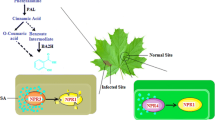Abstract
Changes in the thiocyanate content in hypocotyl-roots and leaves of radish were observed in a two-year field experiment. Six cultivars were tested: early radish (Rex and Ostergruss Różowa), Japanese radish (Tokinashi and Minowase Summer Cross F1), and winter radish (Monachijska Biała and Murzynka). A significant diversification in thiocyanate content among cultivars, plant parts, harvest dates and observation years was found. Early cultivars contained the least amount of these compounds, Murzynka — the greatest. The content of thiocyanates in leaves was 3 – 5 times higher than that in hypocotyl-roots. The changes in the thiocyanate content during root growth showed a constant rising tendency in the case of the leaves of all cultivars and the storage organs of Murzynka.
Similar content being viewed by others
References
Bible B., Chong C., 1975 a. Content of thiocyanate goiterogen in radishes as related to nutrient concentration and sulphur nutrition. J. Amer. Soc. Hort. Sci. 100(4): 428–431.
Bible B., Chong C., 1975 b. Correlation of temperature and rainfall with thiocyanate ion content in roots of radishes grown on two soil types. HortScience. 10(5): 484–485.
Capecka E., 1996. Changes in the contents of some organic compounds during hypocotyl-root growth of radish Raphanus sativus L. cultivars. Folia Hort. 8/2: 121–129.
Carlson D. G., Daxenbichler M. E., VanEtten C. H., Hill C. B., Williams P. H., 1985. Glucosinolates in radish cultivars. J. Amer. Soc. Hort. Sci. 110(5): 634–638.
Chong C., Bible B., 1974. Variation in thiocyanate content of radish plants during ontogeny. J. Amer. Soc. Hort. Sci. 99(2): 159–162.
Chong C., Bible B., 1975. Influence of seed on thiocyanate content of radishes. J. Sci. Fd Agric. 26: 105–108.
Fenwick G. R., Heaney R.K., Mullin W.J., 1983. Glucosinolates and their breakdown products in food and food plants. CRC Critical Reviews in Food Science and Nutrition. 18(2): 123–201.
Freeman G. G., Mossadeghi N., 1972. Influence of sulphate nutrition on flavour components of three cruciferous plants: radish (Raphanus sativus), cabbage (Brassica oleracea capitata) and white mustard (Sinapis alba). J. Sci. Fd Sci. 23: 387–402.
Fritz D., Weichman J., Nebel H., 1987. Influence of provenance and harvest date on some quality properties of horse radish (Armoracia rusticana) for preservation purposes. Acta Horticulturae. 220: 425–431.
Ishii G., Saijo R., 1987. Effect of season, soil type, sulphate level, mulching and plant density on isothiocyanate content in radish root juice. J. Japan. Soc. Hort. Sci. 56(3): 313–320.
Ishii G., Saijo R., Mizutani J., 1989a. A quantitative determination of 4-methylthio-3-butenyl glucosinolate in daikon (Raphanus sativus L.) roots by gas liquid chromatography. J. Japan. Soc. Hort. Sci. 58(2): 339–344.
Ishii G., Saijo R., Nagata M., 1989 b. The difference of glucosinolate content in different cultivar of daikon roots (Raphanus sativus L.). Nippon Shokuhin Kogyo Gakkaishi. 36(9): 739–742.
Johnston T. D., Jones D. I. H., 1966. Variations in the thiocyanate content of kale varieties. J. Sci. Fd Agric. 17: 70–71.
Joshi O. L., Chauhan K. S., 1985. Effect of nitrogen and sulphur on vegetative growth, yield and quality of radish. Ind. J. Hort. 42(3/4): 263–267.
Khomenko A. D., Chernova L. M., 1981. Response of radish plants to the level of sulphur nutrition in soil. Fiziol. i Biol. Kulturnych Rast. 13(2): 169–172.
Kim Y. S., Kim Y. C., Park K. W., 1983. Influence of irrigation and cultivar on thiocyanate ion content in radish and Chinese cabbage. J. Kor. Soc. Hort. Sci. 24(1): 9–13.
Koter M., Benedycka Z., 1984. Wpływ zróżnicowanego nawożenia mineralnego na plonowanie i skład chemiczny rzodkwi zwyczajnej. Biul. Warzyw. XXVII: 317–336. (in Polish)
Lutomski J., Speichert H., 1982. Schwarzrettich als Quelle einiger Phytopharmaka. Pharm. in u. Zeit. 11(5): 151–155.
Neil L. J., Bible B., 1972. Thiocyanate ion (SCN−) content of hypocotyl-root region of Raphanus sativus as affected by environment. J. Sci. Fd Agric. 23: 1379–1382.
Okano K., Asano J., Ishii G., 1990. Contents of pungent principle in roots of Japanese radish (Raphanus sativus L.) cultivars. J. Japan. Soc. Hort. Sci. 59(3): 551–558.
Olsen O., Sorensen H., 1981. Recent advances in the analysis of glucosinolates. J. Amer. Oil Chem. Soc. 58(9): 857–865.
Ozawa Y., Uda Y., Ohishima T., Saito K., Maeda Y., 1990. Formation of yellow pigment by reaction of 4-methylthio-3-butenyl isothiocyanate with L-ascorbic acid and some dihydroxyphenolic compounds. Agric. Biol. Chem. 54(3): 605–611.
Park K. W., Kim M. Z., 1985. Studies on the quality of radish. II. Differences of some quality components between cultivars and parts of the root. J. Kor. Soc. Hort. Sci. 26(3): 226–230.
Rumińska A., 1990. Rzodkiew czarna. in: Leksykon Roślin Leczniczych. PWRiL. Warszawa: 449. (in Polish)
Sang J. P., Minchinton I. R., Johnstone P. K., Truscott R. J. W., 1984. Glucosinolate profiles in the seed, root and leaf tissue of cabbage, mustard, rapeseed, radish and swede. Can. J. Plant Sci. 64: 77–93.
Trzebny W., 1962. Glikozydy izotiocyjanianowe rzepaku jarego i gorczycy sarepskiej oraz ich ilościowe zmiany w różnych fazach rozwojowych roślin. Pamiętnik Puławski — Prace IUNG. 8: 315–322. (in Polish)
Author information
Authors and Affiliations
Rights and permissions
About this article
Cite this article
Capecka, E. Changes in thiocyanate content in some radish Raphanus sativus L. cultivars during hypocotyl-root growth. Acta Physiol Plant 20, 135–142 (1998). https://doi.org/10.1007/s11738-998-0004-6
Received:
Accepted:
Published:
Issue Date:
DOI: https://doi.org/10.1007/s11738-998-0004-6




